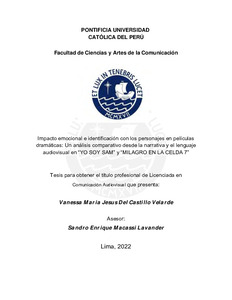| dc.contributor.advisor | Macassi Lavander, Sandro Enrique | |
| dc.contributor.author | Del Castillo Velarde, Vanessa Maria Jesus | |
| dc.date.accessioned | 2023-01-24T21:44:08Z | |
| dc.date.available | 2023-01-24T21:44:08Z | |
| dc.date.created | 2022 | |
| dc.date.issued | 2023-01-24 | |
| dc.identifier.uri | http://hdl.handle.net/20.500.12404/24104 | |
| dc.description.abstract | La presente investigación buscar acercar al lector a la relación que existe entre los diferentes
elementos audiovisuales, la narrativa audiovisual y los efectos que se producen en el
espectador tras el visionado de una película, teniendo en cuenta que éste cumple un rol activo
y crítico en la actualidad. En ese sentido, se busca responder a la pregunta: ¿cómo se logra
conectar con películas que muestran una realidad completamente alejada de la propia, como
la de personas que conviven con trastornos de salud mental? Para ello, es importante saber
hasta qué punto un discurso narrativo complementado con un correcto uso del lenguaje
audiovisual puede traer efectos de identificación y de empatía en la audiencia.
A través de esta investigación se concluyó que, a pesar de ser historias alejadas de la propia
realidad, una correcta construcción del personaje y una historia dramática basada en abusos
sociales, en el caso de las dos películas analizadas, favorece la identificación de los
espectadores a través de la resonancia personal o de la empatía.
Además, al complementarlo con el correcto uso de planos cerrados y musicalización, la
audiencia sentirá que se rompe esa brecha de ficción-realidad. Sin embargo, no es una regla
general, ya que aún presentándose todos los elementos, el romper dicha brecha dependerá
mucho qué tan inmerso se haya sentido el espectador al momento del visionado, de sus
vivencias y preconcepción del tema. | es_ES |
| dc.description.abstract | This research seeks to bring the reader closer to the relationship between the different
audiovisual elements, the audiovisual narrative and the effects produced in the viewer after
watching a film, taking into account that the viewer plays an active and critical role
nowadays. In this sense, we seek to answer the question: how does one manage to connect
with films that show a reality completely different from one's own, such as that of people
living with mental health disorders? To this end, it is important to know to what extent a
narrative discourse complemented with a correct use of audiovisual language can bring about
identification and empathy effects in the audience.
Through this research it was concluded that, despite being stories far from reality itself, a
correct construction of the character and a dramatic story based on social abuses, in the case
of the two films analyzed, favors the identification of viewers through personal resonance or
empathy.
Moreover, by complementing it with the correct use of close-up shots and musicalization,
the audience will feel that this fiction-reality gap is broken. However, this is not a general
rule, since even if all the elements are present, breaking this gap will depend a lot on how
immersed the viewer has felt at the moment of viewing, on his or her experiences and
preconception of the subject. | es_ES |
| dc.language.iso | spa | es_ES |
| dc.publisher | Pontificia Universidad Católica del Perú | es_ES |
| dc.rights | info:eu-repo/semantics/openAccess | es_ES |
| dc.rights.uri | http://creativecommons.org/licenses/by-nc-sa/2.5/pe/ | * |
| dc.subject | Películas--Aspectos psicológicos | es_ES |
| dc.subject | Consumidores | es_ES |
| dc.subject | Comunicación audiovisual | es_ES |
| dc.title | Impacto emocional e identificación con los personajes en películas dramáticas: Un análisis comparativo desde la narrativa y el lenguaje audiovisual en “YO SOY SAM” y “MILAGRO EN LA CELDA 7” | es_ES |
| dc.type | info:eu-repo/semantics/bachelorThesis | es_ES |
| thesis.degree.name | Licenciado en Comunicación Audiovisual | es_ES |
| thesis.degree.level | Título Profesional | es_ES |
| thesis.degree.grantor | Pontificia Universidad Católica del Perú. Facultad de Ciencias y Artes de la Comunicación. | es_ES |
| thesis.degree.discipline | Comunicación Audiovisual | es_ES |
| renati.advisor.dni | 07562415 | |
| renati.advisor.orcid | https://orcid.org/0000-0003-1037-1617 | es_ES |
| renati.author.dni | 73149945 | |
| renati.discipline | 211086 | es_ES |
| renati.juror | Rubina Vargas, Celia Isabel | es_ES |
| renati.juror | Macassi Lavander, Sandro Enrique | es_ES |
| renati.juror | Chavez Lopez, Paula Marianella | es_ES |
| renati.level | https://purl.org/pe-repo/renati/level#tituloProfesional | es_ES |
| renati.type | https://purl.org/pe-repo/renati/type#tesis | es_ES |
| dc.publisher.country | PE | es_ES |
| dc.subject.ocde | https://purl.org/pe-repo/ocde/ford#5.08.00 | es_ES |







